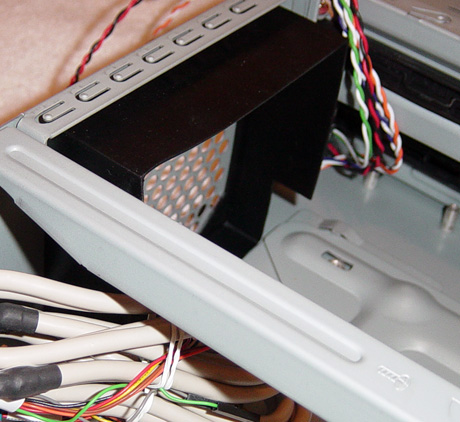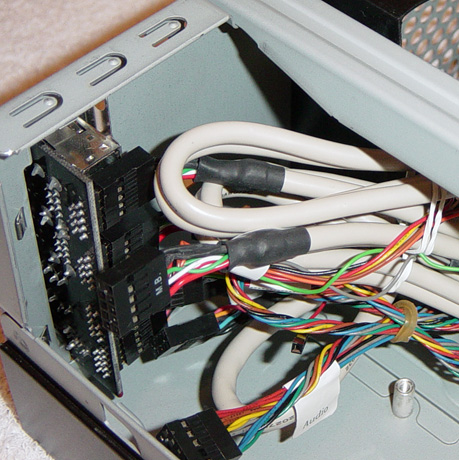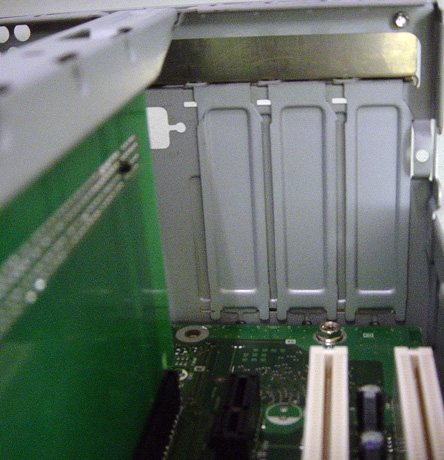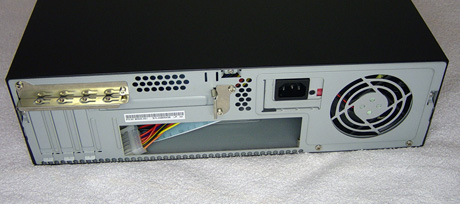Intel's Long Awaited BTX Form Factor
by Purav Sanghani on November 15, 2004 5:31 AM EST- Posted in
- Cases/Cooling/PSUs
First Look: AOpen B300 BTX case cont'd
Internal Design cont'dAt the front of the case is a rubber surround which the thermal module will fit into to provide insulation and to keep warm air from seeping back into the case. To the left of that we see a support bar which spans the depth of the B300 from front to back. As we will see later this bar provides support not only for the structure of the case, but also to hold the PCIe riser card in place. To remove this bar there is a screw at the front of the case that needs to be removed. We then lift the bar from the front, pivoting the backside in its slot and pull up.

Click to Enlarge
To the left of the bar is the auxiliary port module which is home to the internal USB, audio, and FireWire connections. This module is designed with headers so unused ports can be unplugged from the inside to reduce clutter. We also notice that the front panel connections (power/reset buttons, power/HDD activity lights) are also grouped into a single plug to make things easier. It looks like motherboard and case manufacturers are finally working together to standardize more than just the location of the CPU.

Click to Enlarge
The backside of the case consists of 3 vertical half height expansion slots and one full height slot which is positioned horizontally. This, we can safely assume, is where the PCIe x16 VGA card will reside. The I/O backplate is positioned beneath this full length slot.

Click to Enlarge
To secure expansion cards in place there are devices in place on the outside of the B300. Each device, one for the single PCIe x16 slot and one for the other three expansion slots, can be undone by removing a single screw and then pivoting them off the cards' brackets. This feature reduces the number of screws needed but, unfortunately, does not make it a tool-less feature.

Click to Enlarge
Installation
Installing the motherboard was simple since there wasn't much to get in the way if it. We placed the D915GMH on the stand-offs and applied the included screws. We did notice that the tool-less optical mounting device on the inside of the drive bay could not be opened once the motherboard was in place. Luckily the lower HDD bay can be removed by undoing a single screw and sliding the bay back towards the power supply.

Click to Enlarge
There was still an issue with those tool-less devices interfering with the thermal module's fan power header on the motherboard. Unless we plugged in the power cable before replacing the drive bay, it would not stay in place on the motherboard header. We again would need to remove the HDD bay to plug the cable back into the motherboard.

Click to Enlarge
Besides those issues all other parts of the installation carried on smoothly. Our optical drive installed without a hitch since there was nothing to get in the way of the tool-less mounting devices. However, we ran into a clutter problem with the cabling behing the drive bays. As we mentioned earlier the 3 inches of clearance was just not enough to work freely with drive cables, and if it weren't for SATA, there would have been no way to run an IDE ribbon cable to the IDE header on the motherboard. For those that only have the IDE option, we suggest sticking with rounded cables if dealing with this combination of hardware.










77 Comments
View All Comments
ZobarStyl - Monday, November 15, 2004 - link
God looking at those small cases makes me tremble and remember my parent's old IBM Pentium I system where you had to remove the PSU and the CD drive to install the RAM. I was so glad when I saw computers moving AWAY from this type of design...forget footprint, I want a case I can actually work in.Either way, congrats to Intel on making a new Delleron case, but I'm simply not interested. Great for OEM's but useless for me, just like most of Intel's products...
As for #3's question, why does Intel need it outside of helping their OEM buddies? Dual core is only going to make Prescott's heat issues stand out further and their x20/30/40's on the roadmap still are clocked in the range where they are going to be high heat output. All that heat has to go somewhere...
shabby - Monday, November 15, 2004 - link
#5 that must be the canadian version, it'll keep us warm during winter by exhausting warm air into our faces.Jeff7181 - Monday, November 15, 2004 - link
Am I reading this right... warm air from the CPU is exhausted out the FRONT of the case????mcveigh - Monday, November 15, 2004 - link
I can't get past page 1??????skunkbuster - Monday, November 15, 2004 - link
will intel even need btx anymore? since they are probably going to be dumping the p4 in favor of the pM(eventually)?i thought one of the main reasons why btx was designed was to better handle the hotter p4 processors and to cool them more efficiently?
PuravSanghani - Monday, November 15, 2004 - link
Thanks MAME, problem fixed :)MAME - Monday, November 15, 2004 - link
thumbnail of this article doesn't load on front page